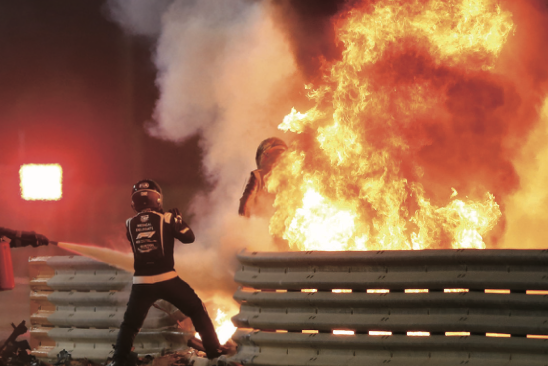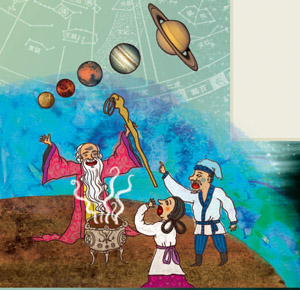과학자들은 80년전 중앙 시베리아에서 발생하였던 한 사건에 대해 여전히 미심쩍어 하고 있다. 그들은 아직도 이 지역을 조사하며 다니고 있고, 오늘날까지 그것에 관한 새로운 증거를 발굴하고 있다.
1908년 6월 30일, 퉁구스카강 근처에 있는, 중앙 시베리아의 하늘이 밝아지면서 무시무시한 폭발이 일어났다. 수백평방 마일의 숲들이 뒤집어 엎어졌고, 모든 나무들은 쓰러졌다. 순록 떼가 전멸했다.
다행스럽게도, 그 황량한 폭발지역의 수마일 반경내에서는 사람이 없었고 그래서 죽은사람은 없었다. 그러나 그곳에서 50마일 떨어진 교역소에 있던 한 사람은 폭발력으로 인해 의자에서 나가 떨어졌고, 다른 원거리의 목격자들은 그 광격을 보고, 듣고, 느꼈다.
과학자들이 거의 접근이 불가능한 그 지역으로 나아가기까지에는 오랜 시간이 걸렸고, 형편은 1차 세계대전이 일어나고 이어 러시아의 혁명과 내란의 시기가 이어졌다는 사정으로 개선이 되지 못했다. 소비에트의 조사자들이 마침내 그 폭발지역에 다다른 것은 1920년대가 한창 되어서의 일이다.
그러나 진짜로 불가사의한 일이 시작된 것은 그때였다. 모든 사람들은 십만에서 수백만 톤까지로 추정되는 거대한 운석이 시베리아를 강타한 것으로 생각하였다. 직경이 약 2백50피트되는 바위 덩어리나 직경이 80피트 정도 되는 쇳 덩어리일 것이라고 추정되었다. 어느 경우든, 그것은 초속 20마일 정도의 속도로 지구에 진입하여 대규모 수소 폭탄만큼의 피해를 가져왔을 것같다는 것이다(물론, 방사능 낙진은 빼고).
그 충돌은 커다란 구멍을 팠을 것이고, 아마도 그 운석을 땅속에 묻거나 그 일대를 쇠나 운석의 파편들로 뒤덮었을지 모른다. 조사자들은 충돌이 일어났던 바로 그 지점을 발견하였다. 왜냐하면 쓰러진 모든 나무들이 그 지점의 반대방향을 가리키고 있었기 때문이다. 그러나 그 곳에는 패인 구멍도, 운석 조각도 없었다.
유일하게 합리적인 결론은 폭발이 땅에서가 아니라 공중, 아마도 지상에서 5마일 떨어진 상공에서 발생한 것으로 가정하는 것이었다. 진입한 물체는 지상에 결코 다다르지 못했다는 것, 즉, 단순히 대기에서 분해되었다는 것이다. 그리고 실제로 폭발은 세계 어느 곳에서나 발견되는 대기의 파동을 일으켰다.
그러나, 그것은 운석이 반응하는 방식치고는 아주 이상한 것이었다. 돌이나 금속은 공중에서 그처럼 폭발하지는 않는다. 만약 그것이 돌이나 금속이 아니었다면 또 보통의 운석이 아니었다면 무엇이겠는가? 아마 직경이 약 3백피트 되는 작은 혜성이거나 보다 큰 혜성의 한 조각이라고 볼 수 있을지 모른다.
혜성은 주로 차가운 물질로, 그 중에서도 주로 얼음으로 이루어져 있다. 혜성이 대기를 질주할 때 공기 저항이 혜성의 온도를 높이게 된다. 암석이나 금속은 가열되어 빛을 발하고, 우리는 '나르는 별' '유성'을 볼 수 있게 된다. 그러나 그때 얼음은 증발한다.
만약 혜성이 대단히 빨리 뜨거워지면 갑작스러운 증발현상이 거대한 폭발을 일으킬수 있다. 이 폭발은 미처 증발할 시간을 갖지 못한 혜성을 산산조각 낼 것이다. 이때 생긴 가스(주로 수증기)는 대기속에 퍼져 나갈것이다. 아무것도 땅에 떨어지는 것은 없을 것이고 다만 폭발현상만 있을 뿐이며 패인 구멍이나 운석의 파편들도 없을 것이다.
이것은 전적으로 만족할 만한 설명으로 여겨진다. 물론, 퉁구스카 사건에 대한 또다른 설명도 진척되었다. 즉 지표면의 보통 물질에 닿을때 폭발해 버리는 조그만 반(反)물질일지도 모르며 그것은 아무것도 남기지 않을 것이다. 또는 다른 별에서 온 핵 우주선일지도 모르는 일이다. 그러나 이런류의 다른 설명들은 신중히 고려된 것은 아니다. 그러나 1987년 초, 일단의 소비에트 조사자들은 충돌 지점에서 채취된 흙 속에서 비정상적으로 높은 이리듐 금속의 흔적을 발견하였다고 보고하였다. 이리듐은 지구 표면에는 거의 없는 원소이고, 그 대부분은 지구의 중앙 핵에 있다. 운석에는 이것이 상당히 집중되어 있는데, 그래서 땅 표면에서 통상보다 더 많은 양이 나타난다는 것은 운석이 충돌한 흔적이라고 간주되었다. 그러나 혜성에는 어떤 이리듐도 포함되어 있지 않다. 그러므로 새로운 소비에트의 발견은 퉁구스카 사건이 혜성이 아니라 운석에 의한 것이었다는 것을 시사하는것 같다.
그렇다면 패인 자국은 어디에 있는가? 소비에트의 조사자들은 침입 물체가 이리듐이 풍부하고, 먼지가 많은 물질로 둘러싸인 혜성이라고 제시하고 있다. 이것은 이리듐은 있고 패인 자국은 없는 상태를 설명해 준다. 그럼에도 모든 사람이 그것을 수긍한 것은 아니었다. 사건은 여전히 수수께끼로 남아있다. 두가지 점이 지적될 수 있다. 중앙 시베리아는 아마도 그런 사건이 인명의 살상없이 일어날 수 있었던 유일한 장소라는 것이다. 만약 그것이 바다에서 일어났다면, 급격한 해일을 일으켰을 것이다. 그리고 그 밖의 지구 어디에선가 일어났다면, 엄청난 수의 사람들이 죽었을 것이다.
둘째, 그런 사건이 지금 소련 혹은 미국에서 일어났다고 가정해보자. 그런 폭발은 적의 핵 폭탄이라고 간주되었을 것이고, 보복대응 공격이 단번에 명령될 수도 있을 것이다. 그 뒤에 따른 참사는 묘사할 수도 없을 것이다.
Scientists are still wondering about an incident that took place in central Siberia 80years ago. They are still poking around in the area and, even today, are uncovering new evidence concerning it.
On June 30, 1908, the skies over central Siberia, near the Tunguska River, lit up and there was a terrific blast. Hundreds of square miles of forest were leveled-every tree down. A herd of reindeer was wiped out.
Fortunately, there were no people within many miles of the explosion in that desolate area so that no human being was killed. However, a person at a trading post 50 miles away was knocked out of his chair by the blast's force, and other distant observers saw, heard and felt the effects.
It took a long time for scientists to make their way out to that all-but-inaccessible place, and things weren't helped by the fact that World WarⅠ came along, followed by years of revolution and civil war in Russia. It wasn't till well into the 1920s that Soviet investigators finally reached the scene.
That was when the real mystery started. Everyone assumed that a large meteorite had struck Siberia, one that weighed any-where from 100,000 to several million tons. It might have been a lump of rock about 250 feet across, or a lump of iron about 80 feet across. In either case, as it came speeding into the Earth at 20 milis a second or so, it would have done the damage of a large-sized hydrogen bomb(minus the radioactive fall-out, of course).
Such an impact would have gouged out a large crater and would have perhaps left the meteor buried in the Earth, or strewed the landscape with pieces of iron or meteoric rock. Investigators found the exact point of impact, since all the fallen trees pointed away from it, but at that point there was neither a crater nor meteoric pieces.
The only reasonable conclusion was to suppose that the explosion had taken place not on impact with the ground but in the air, perhaps five miles above the ground. The incoming object never reached the ground, in other words, and simply distributed itself through the atmosphere. And, indeed, the blast had produced waves in the atmosphere that had been detected everywhere in the world.
That would be a strange way for a meteor to react, however. Stone or metal would not explode in midair like that. But what if it were not stone or metal, and not an ordinary meteorite? It might have been a small comet, about 300 feet across, or a fragment of a larger one.
A comet is made up largely of icy materials-frozen water chiefly. As it raced through the atomsphere, air resistance would raise its temperature. Rock or metal would begin to glow and we would see a "shooting star."
Ice, however, would vaporize. If the comet got hot enough quckly, the sudden vaporization could produce a huge explosion, shattering whatever portion of the comet had not yet had a chance to vaporize. The resulting gases(chiefly water vapor) would spread through the atmosphere. Nothing would reach the ground, except the blast, and there would be no crater and no metoric fragments.
This seemed a completely satisfactory explanation. Of course, other explanations of the Tunguska incident were advanced. It might have been a tiny chunk of antimatter expolding when it reached the ordinary matter of Earth's crust, leaving nothing behind.
Or it might have been a nuclear spaceship from some other world that exploded. Such alternate explanations, however, were never taken seriously.
But in early 1987, a group of Soviet investigators reported that they had detected abnormally high traces of the metal iridium in soil obtained from the impact point. Iridium is rare in the Earth's crust, for most of it has settled down in the Earth's central core. It exists in considerably higher concentrations in meteorites, so the presence of higher than usual traces in the crust is considered a relic of a mateoric impact. Comets, however, do not contain any iridium to speak of. The new Soviet finding, therefore, seems to indicate the Tunguska event was caused by a meteor, not a comet.
Then where's the crater? The Soviet investigators suggest that the invading object was a comet that was surrounded by dusty material rich in iridium. That would account for the combination of the presence of iridium and the absence of a crater. Not everyone is going to accept that, though. The event remains a puzzle.
Two points can be made. Central Siberia is about the only place such an event could have happened without human casualties. If it had happened at sea, it would have set off tidal waves. Almost anywhere else on land, people would have died, perhaps in vast numbers.
Second, suppose such an event happened now in the Soviet Union or in the United States. Such a blast might be taken to be an enemy nuclear bomb, and a vengeful. The horrors that would follow would be indescribable.

















